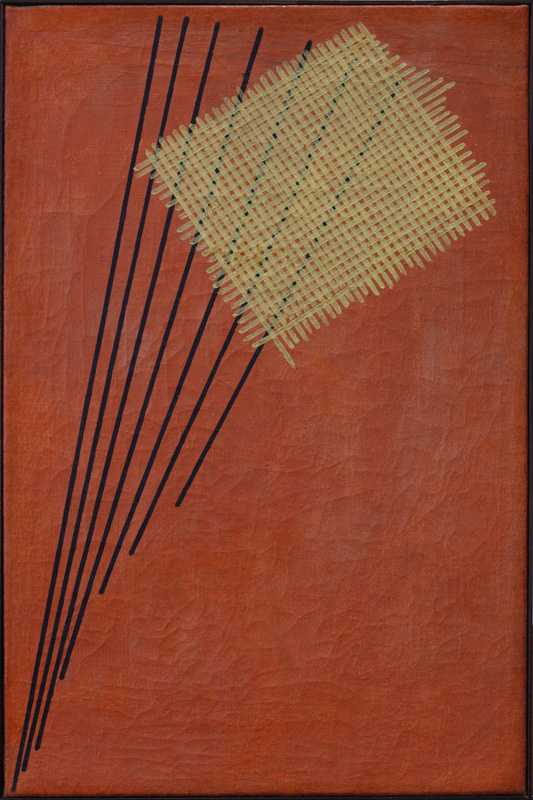THE RAY OF DISPLACEMENT (1)
By:
January 8, 2024

Construction no. 95 (1919)
Harriet Prescott Spofford’s “The Ray of Displacement” — which makes the shocking suggestion, at one point, that Jesus may have been a dimension-hopping scientist — was first published October 1903 in The Metropolitan Magazine, with illustrations by Lester Ralph. It has appeared in proto-sf collections edited by Sam Moskowitz, Mike Ashley, and others. HiLoBooks is pleased to serialize it here for HILOBROW’s readers.
ALL INSTALLMENTS: 1 | 2 | 3 | 4 | 5 | 6 | 7 | 8.
“We should have to reach the Infinite to arrive at the Impossible.”
It would interest none but students should I recite the circumstances of the discovery. Prosecuting my usual researches, I seemed rather to have stumbled on this tremendous thing than to have evolved it from formulæ.
Of course, you already know that all molecules, all atoms, are separated from each other by spaces perhaps as great, when compared relatively, as those which separate the members of the stellar universe. And when by my Y-ray I could so far increase these spaces that I could pass one solid body through another, owing to the differing situation of their atoms, I felt no disembodied spirit had wider, freer range than I. Until my discovery was made public my power over the material universe was practically unlimited.
Le Sage’s theory concerning ultra-mundane corpuscles was rejected because corpuscles could not pass through solids. But here were corpuscles passing through solids. As I proceeded, I found that at the displacement of one one-billionth of a centimeter the object capable of passing through another was still visible, owing to the refraction of the air, and had the power of communicating its polarization; and that at two one-billionths the object became invisible, but that at either displacement the subject, if a person, could see into the present plane; and all movement and direction were voluntary. I further found my Y-ray could so polarize a substance that its touch in turn temporarily polarized anything with which it came in contact, a negative current moving atoms to the left, and a positive to the right of the present plane.
My first experience with this new principle would have made a less determined man drop the affair. Brant had been by way of dropping into my office and laboratory when in town. As I afterwards recalled, he showed a signal interest in certain toxicological experiments. “Man alive!” I had said to him once, “let those crystals alone! A single one of them will send you where you never see the sun!” I was uncertain if he brushed one off the slab. He did not return for some months. His wife, as I heard afterwards, had a long and baffling illness in the meantime, divorcing him on her recovery; and he had remained out of sight, at last leaving his native place for the great city. He had come in now, plausibly to ask my opinion of a stone–a diamond of unusual size and water.
I put the stone on a glass shelf in the next room while looking for the slide. You can imagine my sensation when that diamond, with something like a flash of shadow, so intense and swift it was, burst into a hundred rays of blackness and subsided — a pile of carbon! I had forgotten that the shelf happened to be negatively polarized, consequently everything it touched sharing its polarization, and that in pursuing my experiment I had polarized myself also, but with the opposite current; thus the atoms of my fingers passing through the spaces of the atoms of the stone already polarized, separated them negatively so far that they suffered disintegration and returned to the normal. “Good heavens! What has happened!” I cried before I thought. In a moment he was in the rear room and bending with me over the carbon. “Well,” he said straightening himself directly, “you gave me a pretty fright. I thought for a moment that was my diamond.”
“But it is!” I whispered.
“Pshaw!” he exclaimed roughly. “What do you take me for? Come, come, I’m not here for tricks. That’s enough damned legerdemain. Where’s my diamond?”
With less dismay and more presence of mind I should have edged along to my batteries, depolarized myself, placed in vacuum the tiny shelf of glass and applied my Y-ray; and with, I knew not what, of convulsion and flame the atoms might have slipped into place. But, instead, I stood gasping. He turned and surveyed me; the low order of his intelligence could receive but one impression.
“Look here,” he said, “you will give me back my stone! Now! Or I will have an officer here!”
RADIUM AGE PROTO-SF: “Radium Age” is Josh Glenn’s name for the nascent sf genre’s c. 1900–1935 era, a period which saw the discovery of radioactivity, i.e., the revelation that matter itself is constantly in movement — a fitting metaphor for the first decades of the 20th century, during which old scientific, religious, political, and social certainties were shattered. More info here.
SERIALIZED BY HILOBOOKS: James Parker’s Cocky the Fox | Annalee Newitz’s “The Great Oxygen Race” | Matthew Battles’s “Imago” | & many more original and reissued novels and stories.
